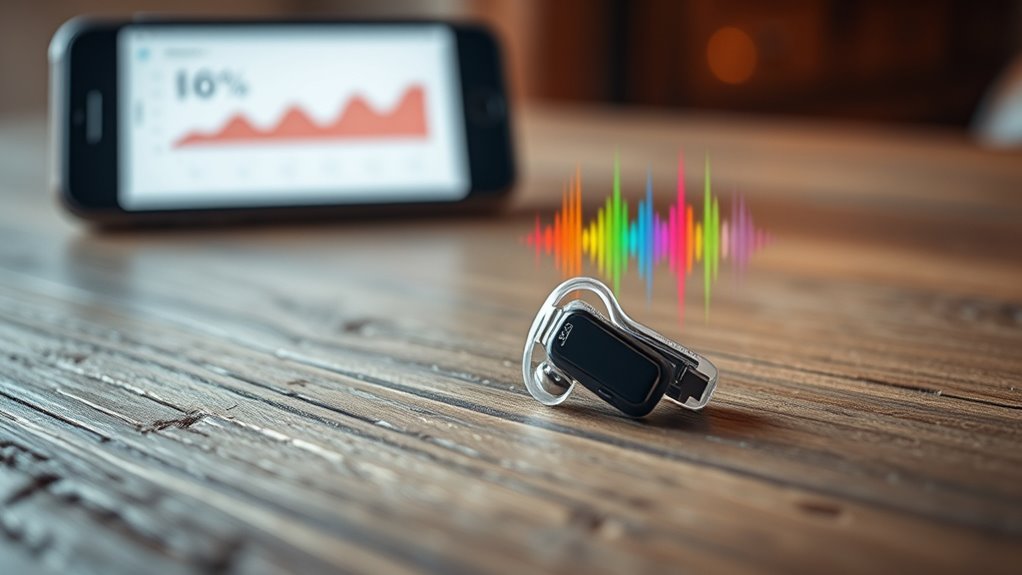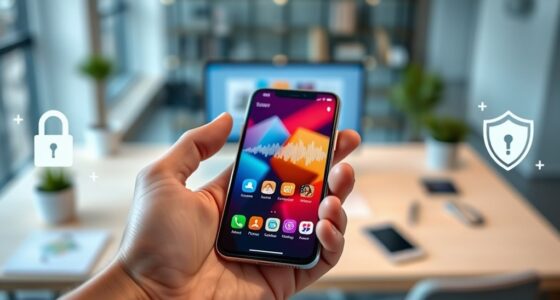AI-powered hearing aids use machine learning to automatically adjust sound in real time, creating a personalized listening experience. They continuously analyze your environment, identifying speech, background noise, and other cues. The device then dynamically modifies amplification, filtering, and directionality to suit your surroundings. Over time, it learns your preferences and specific environments, making adjustments without manual input. Keep exploring, and you’ll discover how this technology transforms your hearing experience into something natural and effortless.
Key Takeaways
- Machine learning algorithms analyze ambient sounds to automatically adjust amplification, filtering, and directionality for optimal hearing in real time.
- AI continuously monitors environmental cues to personalize sound profiles based on user preferences and specific listening scenarios.
- Hearing aids learn from user behavior over time, refining sound settings to improve clarity and reduce background noise automatically.
- Personalized profiles enable seamless adaptation across diverse environments like cafes, offices, and outdoor settings without manual input.
- Ongoing data collection allows AI to enhance sound quality and user experience through iterative updates and algorithm refinement.

Advancements in artificial intelligence are transforming hearing aids from simple amplifiers into intelligent devices that adapt to your environment. With AI-powered features, these devices now offer personalized sound customization that adjusts in real time, giving you a clearer, more natural listening experience. Instead of relying on manual settings, you benefit from user adaptation, where the hearing aid learns your preferences and tailors its response to different situations automatically. Whether you’re in a bustling café, a quiet office, or outdoors, your device uses machine learning algorithms to analyze the soundscape and optimize the audio output accordingly.
The core of this innovation lies in how the device processes sound data. It continuously monitors ambient noise, speech signals, and other environmental cues, then dynamically modifies amplification levels, filtering, and directionality. This means you don’t have to fiddle with settings or switch modes; the hearing aid intuitively recognizes whether you’re having a conversation or just enjoying background music. As a result, sound customization becomes seamless, providing a more natural and effortless hearing experience. Your device essentially becomes an extension of your ear, learning your preferences over time and refining its responses based on your daily listening habits.
User adaptation is at the heart of AI-powered hearing aids. Unlike traditional models with preset programs, these devices employ machine learning to personalize sound profiles that suit your unique hearing needs. The more you use them, the better they understand your environment and preferences. This adaptive capability helps you focus on speech while reducing distracting background noise, making conversations easier and more comfortable. Plus, the device can remember specific environments—like your favorite restaurant or walking route—and adjust accordingly when you return. This personalized approach means your hearing aid becomes more than just a device; it becomes a tailored listening companion.
Furthermore, AI allows for continuous improvement. As your hearing aid gathers data, it updates its algorithms to enhance sound quality and user experience. This ongoing learning process ensures that your device doesn’t just work well out of the box; it evolves with you, offering increasingly refined sound customization and user adaptation. This level of personalization was unthinkable with earlier hearing aid technologies, but now, thanks to machine learning, you get a truly intelligent hearing solution. Additionally, integrating AI in hearing aids aligns with the broader trend of automation’s role in business intelligence, where real-time data analysis and adaptation enhance overall performance. Ultimately, AI-powered hearing aids put you in control of your auditory environment, providing clarity, comfort, and a natural listening experience that adapts seamlessly to your lifestyle.
Frequently Asked Questions
How Long Does It Take to Train a Machine Learning Model for Hearing Aids?
The training duration for a machine learning model depends on the model’s complexity and the dataset size. You might spend hours or days, especially if the model is complex and requires extensive data to personalize sound accurately. Simpler models train faster, but for hearing aids, you need detailed and precise training, which can extend the training process. Overall, it varies, but expect a range from hours to several days.
Can AI Adapt to Different Environments Automatically Without User Input?
You might wonder if AI can automatically adapt to different environments without you needing to intervene. The answer is yes, thanks to advanced context awareness and environmental adaptation features. These hearing aids analyze sound surroundings in real time, adjusting settings instantly to optimize your hearing experience. This seamless adaptation helps you focus on conversations or enjoy quiet moments, making your hearing aids smarter and more intuitive without requiring manual input.
What Are the Privacy Concerns Related to Data Collected by These Devices?
Think of your hearing aid as a vault guarding your personal soundscape. The data it collects raises privacy concerns, like data security breaches and misuse. You need to guarantee your device respects your privacy through strong data security measures. User consent is vital; you should be fully aware of what data is collected and how it’s used. Always read privacy policies to keep your personal information safe and in your control.
How Do Ai-Powered Hearing Aids Compare in Cost to Traditional Models?
You’ll find that AI-powered hearing aids tend to be more expensive than traditional models, mainly due to their advanced features. The cost comparison varies based on pricing factors like technology integration, brand, and customization options. While they often come with higher upfront costs, many users find the benefits of real-time sound personalization and improved hearing worth the investment. Keep in mind, ongoing maintenance and updates can also influence the overall pricing.
Are There Any Risks of Over-Personalization Affecting Sound Quality?
Thinking about over-personalization is like tuning a radio station too precisely—you might miss the broader soundscape. In AI-powered hearing aids, over-personalization can cause sound distortion or user discomfort if settings become too specific. While machine learning adapts to your preferences, it’s essential to balance personalization with natural sound quality. Otherwise, you risk making the experience less comfortable and more confusing, rather than enhancing your hearing.
Conclusion
Just like a skilled conductor harmonizes an orchestra, AI-powered hearing aids fine-tune sounds in real time, creating a seamless listening experience. By personalizing audio to your unique environment and preferences, these devices transform how you connect with the world. Embrace this cutting-edge technology, and let it be the maestro guiding your auditory journey. With AI, every moment is tuned just for you, turning a cacophony into a symphony you’ll always want to hear.











